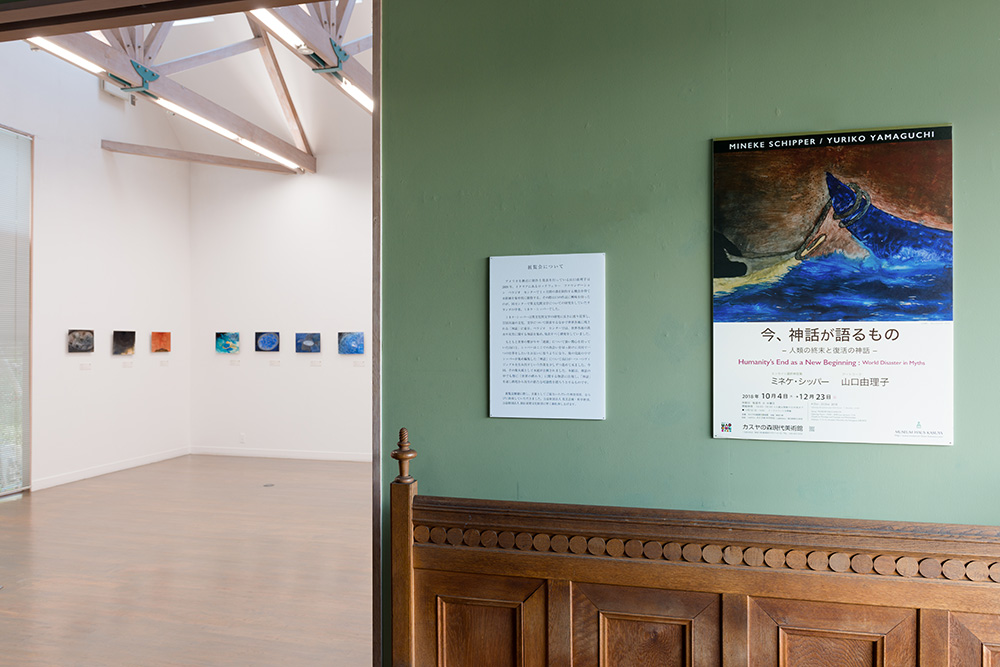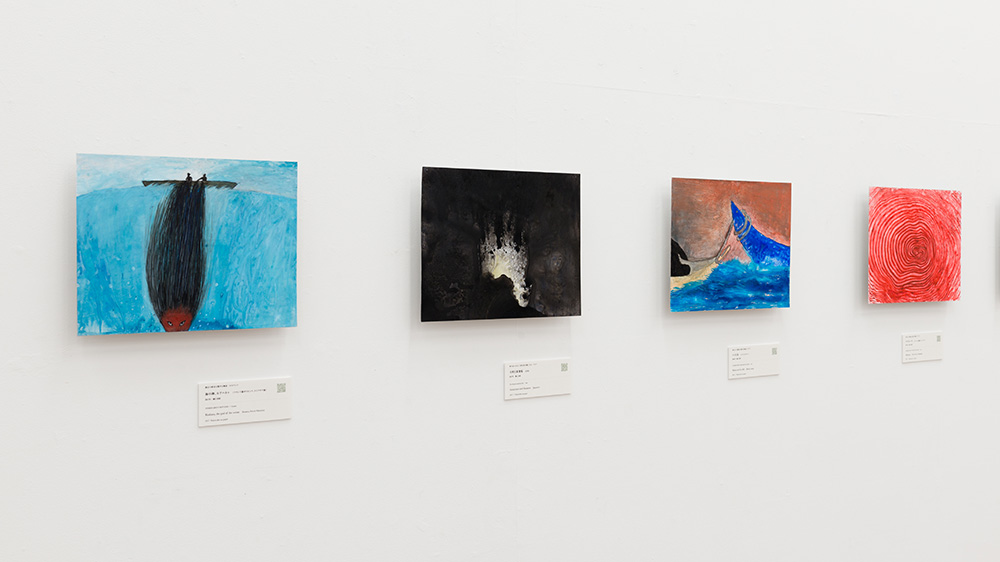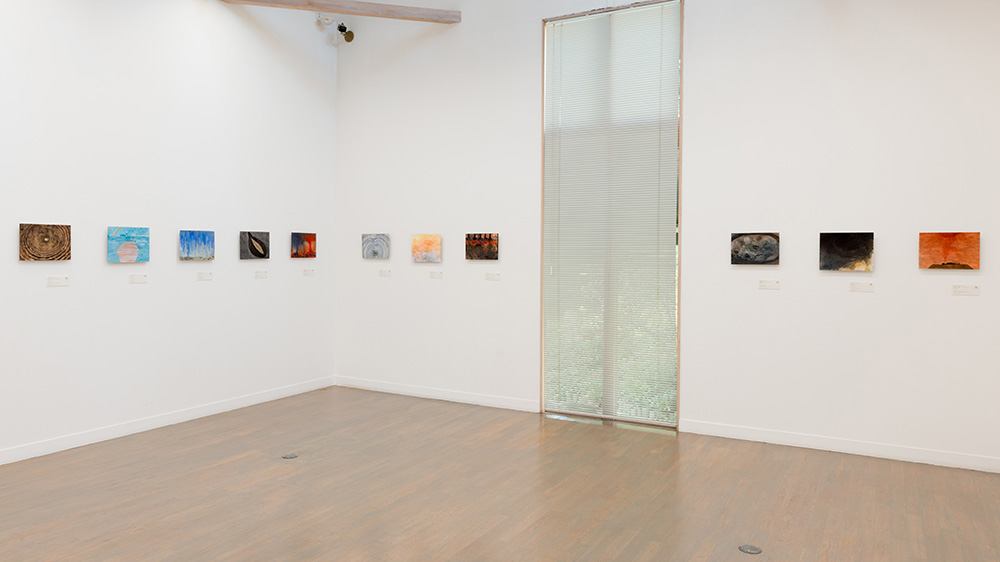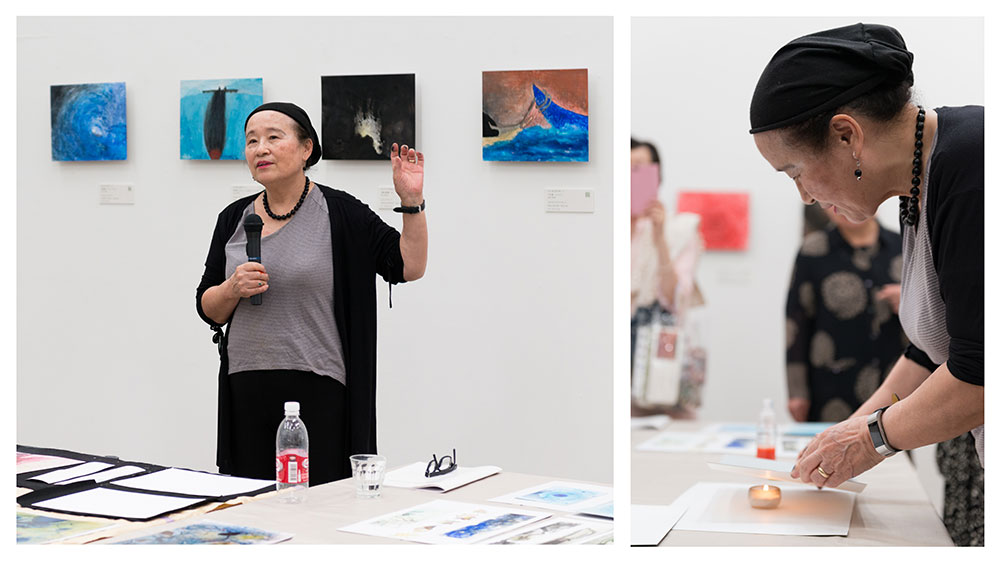
今、神話が語るもの ― 人類の終末と復活の神話 ―
ミネケ・シッパー 山口由理子
2018年10月4日[木]- 12月23日[日]
10:00-18:00(入館は17:30まで)
毎週:月・火・水曜休館
入館料/一般600円、学生500円(小学生300円)
共催:神奈川県
助成:公益財団法人 花王芸術・科学財団/公益財団法人 朝日新聞文化財団
■ 公開制作:10月4日[木]14:00より 山口由理子さんの来日に合わせ、制作過程を一部公開いたします。
■ オープニング + トークイベントを開催 10月7日[日]14:00より アンソロジストの東雅夫さんをゲストに山口由理子さんと対談していただきます。
■ 12月2日[日]高橋アキ ピアノコンサート 開催
私たち、そして、私たちの祖先も、度重なる自然災害や争いで、何度も生命を脅かされ、苦しみ、怯えて来ました。紀元前の人々の社会では、科学的な根拠に基づいた理解は乏しく、地震、噴火、山火事、洪水等は、神の怒りとして捉え、様々な「神話」を生み出して来ました。現在は、自然現象について科学的に解明出来るようになりましたが、自然災害との戦いが止むことは無く、昔の人と同じようにその脅威に怯えています。さらに現代には人間が生み出した「核」という新たな脅威も加わっています… そんな中、私たちの出来る事は、何なのか?

アメリカを拠点に制作と発表を行っている山口由理子は2009年、イタリアにあるロックフェラー ファウンデーション ベラジオ センターで1ヶ月間の滞在制作する機会を得て水彩画を集中的に制作する。その際山口の作品に興味を持ったのが、同センターで異文化間文学についての研究をしていたオランダの学者、ミネケ・シッパーでした。
ミネケ・シッパーは異文化間文学の研究に長きに渡り従事し、万国共通の文化、文学について探求するなかで世界各地に残される「神話」に着目。ベラジオ センターでは、世界各地の洪水や災害に関する神話を集め、発表すべく研究をしていました。
もともと世界の繋がりや「連鎖」について強い関心を持っていた山口と、シッパーはここでの出会いを切っ掛けに共同で一つの仕事をしたいとお互いに思うようになり、後の交流の中でシッパーが集め編集した「神話」について山口が一つ一つヴィジュアルを生み出すという作業を少しずつ進めて来ました。今回、その集大成として本展が企画されました。本展は、神話の中でも特に「世界の終わり」に関する物語に注視し、「神話」を通し終焉から再生の新たな可能性を探ろうとするものです。

※ミネケ・シッパーが世界各地より集め編集した神話30編を山口由理子がヴィジュアル化し、水彩画として現しました。本展では、神話と共にご紹介いたします。

有限性と未来:ミネケ・シッパー
人類は、まだとても若い。たった三十万年ぐらいである。そして文化的に言えばせいぜい五千年ぐらいの古さである。文化や芸術、科学が戦争よりもずっとコストがかからないということを私たちは歴史からそろそろ学ぶべきだ。
人類の終末は必ずしも世界の終末ではない。私たちは単に知らないだけだ。学者たちは、私たちがどんなに無知であるかということをより深く承知している。未来は、学問への信念の問題だけでなく、殆ど同じ程度で宗教や芸術、文学への信念の問題でもある。世界中、気楽な自信が人々を前に進ませる。この自信はチェーホフの戯曲『三人姉妹』に美しく表現されている、「一世紀か二世紀、または一千年たったら、人々は新しい、もっと幸福な生活をしているだろう。私たちはそれを見るまで生きることはないが、だから、私たちは今生き、働く。だから私たちは今苦しむのだ。」
戦争や他の災害の憂鬱な残骸から自らを解き放ちながら、人々はより良い将来への常なる希望に寄り縋る。有限性の恐れにかられて、彼らは新しい始まりを探して進む。
ミネケ・シッパー(オランダ) 1938 ~
元ライデン大学教授。異文化間文学研究者。作家。学術書から小説まで幅広い分野で執筆を手がける。ナイジェリア、ケニア等の大学の客員教授を経て、中国社会科学院(CASS)に在籍。※著作:「なぜ神々は人間をつくったのか―創造神話1500 が語る人間の誕生」など多数
山口由理子 1948 ~
日本で生まれ育ち、後にアメリカに渡り、1975 年にカリフォルニア大学バークレー校で学士、1979 年にメリーランド州立大学で造形芸術の修士号を取得。その後40 数年 アメリカを中心に作家活動を継続している。山口は作家活動を通し、全ての物事が何らかの繋がりを持ち、その関係性の中で起こり、生まれるのではないかという思いに至り、「連鎖」をテーマに彫刻や絵画等様々な作品を創作している。
Humanity’s End as a New Beginning -World Disaster in Myths-
October 4 (Thu) 2018 – December 23 (Sun) 2018
10:00 – 18:00 (Last admission 17:30)
Closed on Mondays, Tuesdays and Wednesdays
Admission:
600 yen for adults
500 yen for students
300 yen for elementary school students
Cosponsored by Kanagawa Prefecture
Sponsored by The Kao Foundation for Arts and Sciences / The Asahi Shimbun Foundation
■ October 7 (Sun) 14:00- Opening Reception with Talk Session
Yuriko Yamaguchi / Masao Higashi (Anthologist)
We and our ancestors have been repeatedly suffered from natural disasters and wars. In the pre-Christian society, lack of scientific understanding of earthquakes, eruptions, wildfires, floods, etc. gave birth to various myths. Even a scientific elucidation does not free us from struggles with natural disasters, meanwhile the human has introduced a new threat – nukes. What can we do now?
Based in the US, Yuriko Yamaguchi was invited in 2009 for residence and production at the Bellagio Center, Rockefeller Foundation in Italy, where Mineke Schipper, a Dutch researcher conducting a research on intercultural literature, encountered Yamaguchi’s watercolor works.
Mineke Schipper has been long engaged in intercultural literature research and is particularly specialized in myths from every corner of the world. At the Bellagio Center, she was in preparation for publication of her research on myths in relation to floods and natural disasters.
Yamaguchi has been having strong interest in links and chains of phenomena. After their encounter at the Bellagio Center, Schipper and Yamaguchi have come to hope for collaboration. The present exhibition features artworks Yamaguchi created on the basis of myths discovered and edited by Schipper, focusing on tales about the end of the world in an attempt to explore the new possibility of resurrection.
30 myths discovered and edited by Schipper were visualized in the form of watercolor paintings by Yamaguchi. The paintings are presented together with the corresponding myths.
Finiteness and Future : Mineke Schipper
Humanity is still very young, only about 300.000 years, and culturally speaking we are not much older than about 5000 years. We could finally learn from history that culture, arts and sciences cost so much less than war.
The end of humanity is not necessarily the end of the world. We simply don’t know. Scholars are more and more aware of how little they know. The future is almost as much a matter of belief in scholarship as it is in religions, arts and literatures. All over the world a comforting self-confidence keeps people going, as a belief beautifully expressed in Chekhov’s play Three Sisters: “In a century or two, or in a millennium, people will live in a new way, a happier way. We won’t be there to see it-but it’s why we live, why we work. It’s why we suffer.”
Struggling themselves free from the depressing debris of wars and other disasters, people clutch the lifelong hope for a better future. Driven by fear of finiteness, they go in search of a new beginning.
Translation by Miho Ida